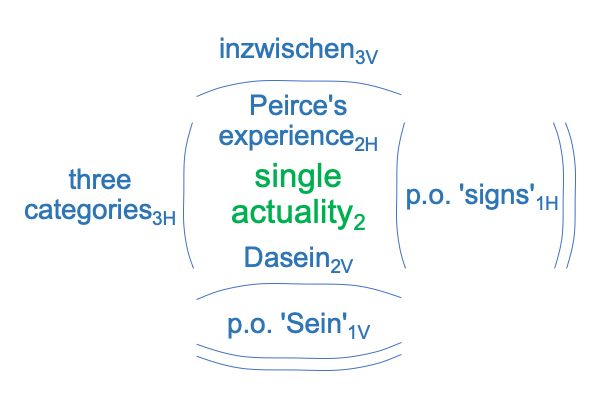0014 Unbeknownst to author, Razie Mah proposes a technical definition of the term, “intersection”, that adorns the title of Brian Kemple’s book. An intersection is a single actuality composed of two actualities. Every intersection is riddled with unresolved, and unresolvable, contradictions. The intersection is inherently mysterious. The philosopher strives to delineate these contradictions, not to resolve them.
0015 Here is the intersection derived from Peirce’s social construction and Heidegger’s construction of Being in the prior blogs.

0017 To me, the coincidence is amazing. Kemple identifies the category-based structure that brings Peirce and Heidegger together and, in the subtitle, suggests a name for the single actuality. The name is “dialogue”.
I wonder if “dialogue” is the same as “delineating a union of two actualities without resolving their contradictions”.
The word that labels the single actuality should intimate the difficulty of Kemple’s task and perhaps, the genius of his approach.
0018 At first, Kemple tempts the reader by mentioning an author who, early on, inspires both Peirce and Heidegger. A manuscript by Thomas of Erfurt, long attributed to the scholastic philosopher Scotus, discusses modes of signification for a speculative grammar. Speculative grammar? Look at the above figure. Should the single actuality be labeled, “speculative grammar”?
Yes, Peirce and Heidegger are inspired by Thomas of Erfurt.
0019 After that tease, Kemple devotes a division (chapters two and three) to Heidegger, followed by a division (chapters four and five) to Peirce. In these two divisions, Kemple introduces a term that takes a step beyond the German compound-words of Umwelt and Lebenswelt. The Umwelt is the significant world for each type of animal. The Lebenswelt denotes the world of signification for our kind, to which I add a caveat.
There are two Lebenswelts. The first is the Lebenswelt that we evolved in (characterized by hand- and hand-speech talk). The second is our current Lebenswelt (characterized by speech-alone talk). In one more step, Kemple introduces the compound-word, “Bildendwelt”, for civilizations within our current Lebenswelt, such as the one discussed in Looking at Heather Heying and Bret Weinstein’s Book (2021) A Hunter-Gather’s Guide to the 21st Century.
